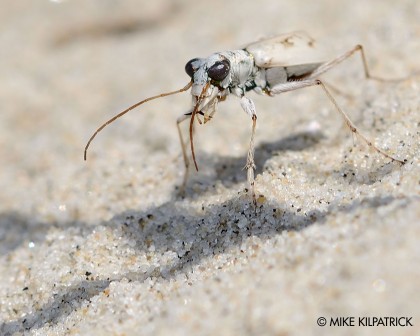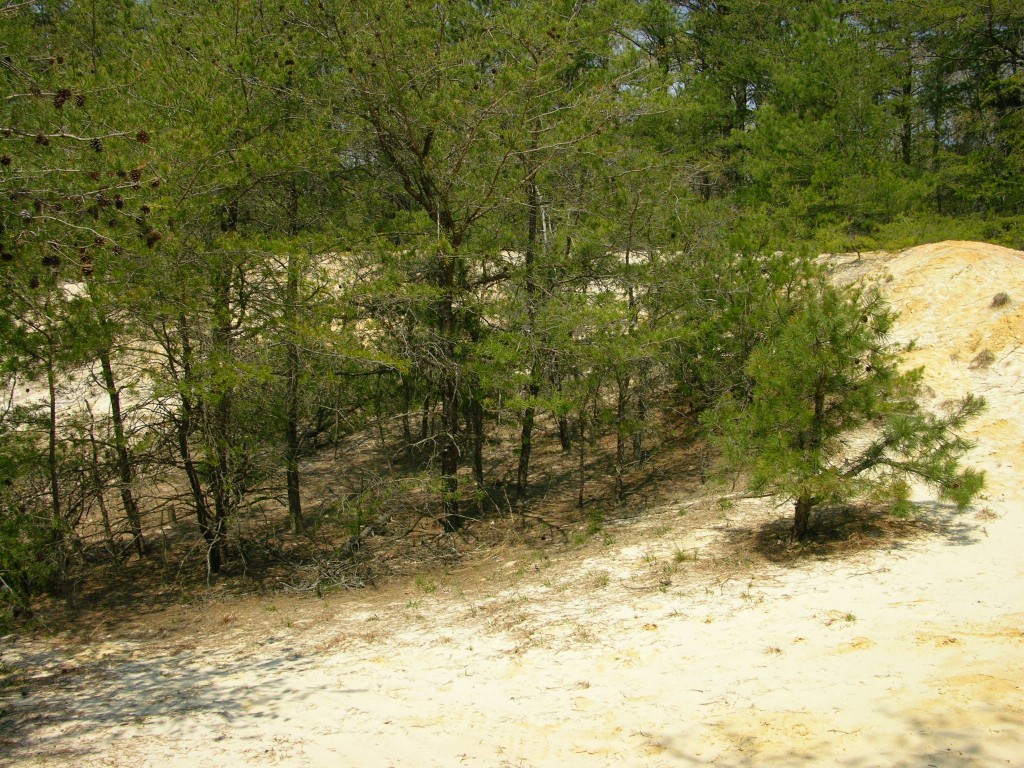
This is the dune ghost (Ellipsoptera lepida), a beautiful cream-colored tiger beetle that I have been getting to know at a few sites in New Jersey. This is a creature of wide open spaces and dry shifting sands.
It is known from only a handful of sites in New Jersey and is declining across its range. As I’ll describe below, I recently added another site to the handful.
The ghost occurs at both coastal dunes and at sandy inland sites. Tiger beetles like the dune ghost are creatures of open terrain, where they actively hunt for prey and find mates.
Open patches of ground are created by either natural or man-made disturbance.
Coastal environments are by nature very dynamic. Sandy shores and dunes are in constant motion, maintaining the open, unvegetated terrrain that tiger beetles require.
Inland sites on the other hand, pretty much depend on man-made disturbance.
It’s likely that big fires were the main natural disturbance factor before human settlement in South Jersey and the Pine Barrens, but in more modern times land clearing, timber cutting, sand mining and roads create and maintain tiger beetle habitat.
As many of these practices wane, tiger beetles are losing habitat to vegetation encroachment.
The photos below show an example of vegetation encroachment. This open sand pit is a man-made feature. Over the decades since activity stopped here, the forest has grown back.
Now the dune ghost and several other tiger beetle species are making their last stand at a tiny hump of vegetation-free sand. I was part of an effort to peel back some of the young growth in this area as you can see in the before/after slider below.

The action did buy the beetles some time and I’ve been pleased to see that tiger beetle larvae are using the cleared area, but such places will always need human intervention to persist.
Although disturbance dependent, tiger beetles can suffer from the wrong kind of disturbance. One of the few Federally endangered tiger beetles is native to Atlantic beaches of the east coast: the northeastern beach tiger beetle.
This beetle’s larvae locate their burrows right on the beach face. Recreational beach use and vehicle traffic have been too disruptive for this species to persist and it now lives in only two places – an Island off of Cape Cod and an isolated piece of ocean-front property on Martha’s Vineyard owned by the Kennedys.
A wild Atlantic coast beach in the Mid-Atlantic ought have at least four species of tiger beetles (including the Northeastern beach and the dune ghost), but the most heavily used beaches of the jersey shore have none owing to the heavy use of vehicles, beach rakes and foot traffic.
We have been forced to write off the Jersey Shore and places like it as wildlife habitat (at least in summer) – there is no room to spare among the beach umbrellas and monster truck rides for beach-nesting birds like piping plovers or beach-nesting bugs like tiger beetles.
But there is one part of these hectic Atlantic coast beaches that is sacrosanct: the dunes.
We all know to keep of the dunes and there is widespread recognition of the value of dunes in shore and property protection. So as ravaged as the rest of the beach is, the dunes are left in peace.
This helps explain a miraculous discovery I made recently.
One day, while shuffling to the beach with beach chairs and boogie boards to join the rest of the tourists, I thought to take a look at these dunes along the way — my beetle senses were tingling.
Imagine my surprise when I found the dune ghost right here at the Jersey Shore. Between the shadow of motels and the merciless beach rakes, a population of beach ghosts were living life amidst a neat row of man-made dunes.
Upon further investigation, I found the population to be extensive and thriving. Great news for this rare species. It seems that these beetles truly only need this one fragment of the beach ecosystem – the dunes.
As long as beach towns value dunes, it seems the dune ghost will have a place at the Jersey Shore.
All photos by me except where noted and the beach umbrella shot by Flickr user, Jim the Photographer.